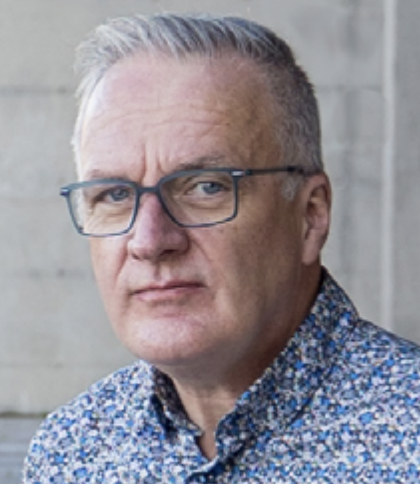
For more than a decade, Professor Stephen Gaetz and the York-based Canadian Observatory on Homelessness (COH), which he directs, have pushed to create a shift in how to approach modern homelessness. They’ve succeeded.
When homelessness arose as a broader societal concern in the 1990s (often referred to as "modern" homelessness), a common game plan emerged. Emergency shelters, soup kitchens, day programs and more became prevalent measures in order to address the situation.

What those responses had in common was that they were reactive, prioritizing the provision of immediate crisis support to those who were already experiencing homelessness. That was what many understood was needed, but it wasn’t a response that actually solved homelessness. Gaetz likens it to a broken water pipe flooding a basement. “First, you get your hands and you're scooping up water. Then you go get a bucket. Later you go get a gas pump from Canadian Tire,” he says. “But at some point you maybe want to fix the pipe.”
In other words, it became clear that prevention – not just reaction – was needed. There was a problem, however. “There was no real interest in prevention on the part of either government or service providers,” says Gaetz, a professor at York's Faculty of Education. There was lack of awareness, skepticism around effectiveness due to perceived lack of evidence and little understanding of who becomes unhoused and when.
To this day, the bulk of the investment in responding to homelessness goes to emergency response, yet the number of people experiencing homelessness continues to grow.
For more than 15 years, Gaetz and the COH at York have been among those driving that change.
Through extensive partnerships they built up prevention awareness using public campaigns. They have also implemented a research agenda that offers an extensive evidence base to show it can work. The COH began aggregating, managing and mobilizing resources with the Homeless Hub, a knowledge-sharing platform that disseminates research, best practices and tools for policymakers, service providers and the public.
Along the way, the important question of how exactly to prevent homelessness remained front of mind. Among key findings that helped point towards an answer was the significance of youth homelessness.
Gaetz notes that even today, many picture a homeless person to be an older, gray-bearded man pushing a shopping cart down the street. However, when Government Canda conducted a homeless population survey in the mid-2010s, COH asked them to include a question about how old individuals were when they had their first experience being unhoused. The results were illuminating. “Of all people who are homeless, regardless of age, 50 per cent identified that they had their first experience before they were 25,” says Gaetz.
That provided an epiphanic way forward: “Young adulthood is a big driver of chronic homelessness. If we change to a prevention focus on youth, not only will we have better outcomes for young people. We would be attacking chronic homelessness right at the start. We'd be fixing that pipe,” he says.
Doing so, however, would require a dramatic conceptual shift – not just away from relying on reactive emergency services and supports, but towards a focus on preventive intervention and support for homeless youth.
In 2017, COH made a major leap forward. Prevention Framework by the Canadian Observatory on Homelessness introduced a report co-authored by Gaetz and titled "A New Direction: A Framework for Homelessness Prevention." The framework provided a refined approach to preventing homelessness by addressing structural, systemic and individual factors before homelessness occurs.
In the same year, Making the Shift (MtS) was established as a partnership between the Canadian Observatory on Homelessness (COH) and A Way Home Canada. It was designed as a Youth Homelessness Social Innovation Lab to develop and test prevention-focused solutions. The latter saw further expansion in 2019 when it became a federally funded Networks of Centres of Excellence (NCE) initiative, expanding its research and pilot programs across Canada. The initiative focuses on family and natural supports, early intervention, housing-first for youth and policy innovation.
“We're the only research institute in the world that focuses on the prevention of youth homelessness,” he says.
Hundreds of presentations, demonstration projects and funded initiatives later, there is now a mass of evidence for the efficacy of prevention, but also knowledge around how to implement it. It led to a recent "watershed moment" when Making the Shift and its partners organized the International Conference on the Prevention of Youth Homelessness this past February in Toronto.
The event brought together researchers, policymakers, service providers and advocates to explore evidence-based solutions for preventing youth homelessness. Over three days, attendees engaged in plenary sessions, workshops, interactive panels and research discussions focused on innovative policies and practical strategies. With over 100 presentations from global experts, the conference fostered cross-sector collaboration and highlighted cutting-edge research that informed effective prevention efforts.
Most notably, more than 600 participants from all over the globe attended, illuminating just how far things have come from a time where Gaetz felt nobody was interested in discussing prevention.
“The biggest thing was the positive energy in the room – after spending the last 10 or 15 years trying to get people to care about the prevention of youth homelessness, here we are in a convention centre in February in Toronto with over 600 people there because they get it.”
While Making the Shift has, indeed, helped shift perception around prevention, the job isn’t done yet, says Gaetz. “The work is going to go on. It's going to shift more to knowledge mobilization and, in a lot of ways, we still need more research to understand how to do things better,” he says.
Still, he is amazed at how much has changed. “We’re on that road. There is readiness," he says. "We’re hearing it from the government. We’re hearing it from service providers. That was unthinkable 10 years ago.
"We have truly come a long way."
